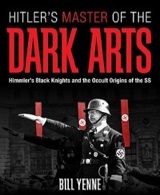Hitler’s Master of the Dark Arts – Book Review
 Hitler’s Master of the Dark Arts: Himmler’s Black Knights and the Occult Origins of the SS. By Bill Yenne. Zenith Press, 2010. 312 pages, hardcover. $30.00.
Hitler’s Master of the Dark Arts: Himmler’s Black Knights and the Occult Origins of the SS. By Bill Yenne. Zenith Press, 2010. 312 pages, hardcover. $30.00.
In the halls of German academia, an odd mix of Saxon mythology, nineteenth-century spiritualism, and fringe archeology all came together.
Black uniforms, death’s-head insignia, the swastika, the hand salute, the Norse runes, and the accompanying “back-story” of fringe beliefs: all serve to reveal the underlying mythological origins of the image cultivated for themselves by the Nazi Party – and in particular the Schutzstaffel (“protection squad”). How did a relatively obscure post-World War I off-shoot of the Communist Party transform itself to become one of the most evil regimes in human history? Bill Yenne considers this question in Hitler’s Master of the Dark Arts. In particular, Yenne looks at the role of Heinrich Himmler in shaping the SS into the very face of Nazism.
{default}As a weak boy with poor eyesight and a bad stomach, Himmler immersed himself in reading stories of the tenth-century Saxon warlords. In his fantasies, Himmler, the son of a schoolmaster, fancied himself the reincarnation of Heinrich I, who is usually credited with being the founder of the German state and its first king. Following World War I, Himmler became part of the progressive Völkische or “back-to-the-land” movement sweeping through Germany. He readily absorbed the Blut und Boden (blood and soil) ideology of the Völkische, which held that one’s “blood” or ethnicity intimately tied one with his “soil” or traditional homeland.
Himmler’s entrance into university coincided with a German nationalism resembling a mixture of the 1960s counterculture and the 1980s New Age movement. In the halls of German academia, an odd mix of Saxon mythology, nineteenth-century spiritualism, and fringe archeology all came together to advance dangerous theories of German might and racial “purity.” Throw in the charismatic figure of Adolph Hitler and the stage was set for the birth of one of the most evil cults in human history.
Yenne is a prolific author who writes on a wide variety of topics, both fiction and non-fiction. His credits include works on a wide range of historical topics, and several have focused on World War II, including Superfortress (co-authored with Curtis LeMay) and Black ’41: The West Point Class of 1941 and American Triumph in World War II. He certainly possesses the background to write this book.
He does a particularly good job showing how various nineteenth-century and early twentieth-century fringe movements came together in 1920s Germany to produce the identity Hitler and Himmler would stamp on the National Socialist German Workers Party. We often forget that neither man started the Nazi Party but instead were able to gain control and mold it in their image. The greatest strength of Yenne’s work is showing us how this happened.
My issues with this work are relatively minor. First, I think the title is a bit of a misnomer. As Yenne shows in the body of the work, the SS and the Nazis drew more from romanticized views of Saxon-German pagan mythology, coupled with crackpot progressive theories about racial purity, than actually from the “occult.” I suppose a marketing agent decided “The Mythological Origins of the SS” wasn’t quite as catchy as “The Occult Origins of the SS.” The title might be misleading for someone thinking the work will present an Indiana Jones–like view of the Nazis as searching for “secret” occult powers. Instead, they were simply brutal street thugs who developed elaborate “back-stories” to rationalize their evil.
My other issue with this work is the lack of endnotes. While the book includes a decent bibliography, I’d like to know specific references for some of Yenne’s statements.
Yes, I realize it is common practice in “popular” history books to omit endnotes, but I continue to believe this is a disservice to the reader—especially the serious reader. Readers: There is no reason to fear endnotes. Publishers: There is no reason to fear including endnotes in your books. I doubt the situation will change anytime soon, but I’ll keep championing for the inclusion of endnotes in all history books. Not only does it allow the reader to delve further into a topic, but it also helps keep the writer “honest” by forcing him to cite specific references for his claims.
Overall, Yenne’s book is an excellent addition to the history of World War II and the history of the Nazi Party in particular. To understand the war in Europe, we must understand Germany. To understand Germany during World War II, we must understand the Nazi Party. To understand the Nazi Party, we must understand its masters: Hitler and Himmler. Once we understand, we can seek to prevent unimaginable evil the next time a charismatic leader attempts to “sell” us with empty, but nice-sounding, slogans.
Steve Schultz is a former active duty Air Force officer and pilot. He holds a master’s degree in military history and writes from southwest Florida.


This post may be focus that is worth everyone’s. When could I find more out?